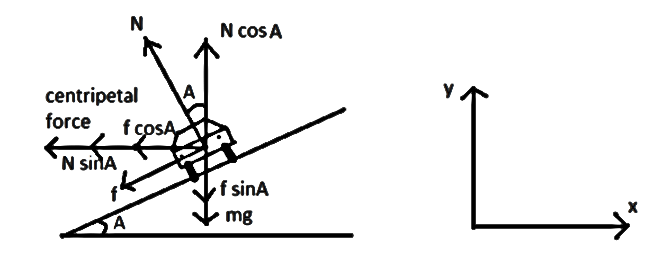
The maximum speed that can be achieved without skidding by a car on circular unbanked road of radius R and coefficient of static friction \[\mu\], is
A. $\mu Rg$
B. $Rg\sqrt{\mu }$
C. $\mu \sqrt{Rg}$
D. $\sqrt{\mu Rg}$
Answer
216.9k+ views
Hint: In order to answer this question, we need to know the maximum speed at which an automobile can go on a round, banked road without skidding. Basically, we balance every aspect of the forces acting in both x- and y-axes on a car.
We constantly balance the forces acting along the x-axis and the y-axis to address any balancing problems, whether the motion is translational or rotational.
We balance the torques acting on the body in the case of rotational motion.
Formula used:
1. Gravitational force= mg
2. Frictional force, $f=\mu N$,
Where \[\mu \] is the coefficient of friction and N is the normal force.
3. Centripetal force= $\dfrac{m{{v}^{2}}}{R}$
Where m is the mass of car, v is the velocity and R is the radius of the road
Complete step by step solution:
We’ll start by equating all the forces and by trying to keep the body in equilibrium as shown in the diagram below:

Let’s balance all the forces along the x axis
$f\cos \theta +N\sin \theta =\dfrac{m{{v}^{2}}}{R}$
We will now substitute $f=\mu N$ in the above equation we get,
$\mu N\cos \theta +N\sin \theta =\dfrac{m{{v}^{2}}}{R}$
$\mu (\cos \theta +\sin \theta )=\dfrac{m{{v}^{2}}}{R}$…….. (i)
Now similarly let’s balance all the forces along y axis
$N\cos \theta =f\sin \theta +mg$
$\Rightarrow N\cos \theta =\mu N\sin \theta +mg$
$\Rightarrow N(\cos \theta -\mu \sin \theta )=mg$…… (ii)
And frictional force Frictional force, $f=\mu N$….. (iii)
Now we will divide the equation (i) by (ii), we get
$\dfrac{{{v}^{2}}}{Rg}=\dfrac{(\mu +\tan \theta )}{(1-\mu \tan \theta )}$
$\Rightarrow v=\sqrt{\dfrac{Rg(\mu +\tan \theta )}{(1-\mu \tan \theta )}}$
For maximum velocity the road is unbanked,$\theta =0{}^\circ $
Therefore, ${{v}_{\max }}=\sqrt{\mu Rg}$
Hence, the correct option is D. $\sqrt{\mu Rg}$
Note: Roads are banked to stop fast cars from skidding. If a car is moving faster than the aforementioned speed, it will slide. If there is inadequate frictional force, the car will slide. Additionally, keep in mind that while the car tries to slide along the road, friction acts downwardly along the surface.
We constantly balance the forces acting along the x-axis and the y-axis to address any balancing problems, whether the motion is translational or rotational.
We balance the torques acting on the body in the case of rotational motion.
Formula used:
1. Gravitational force= mg
2. Frictional force, $f=\mu N$,
Where \[\mu \] is the coefficient of friction and N is the normal force.
3. Centripetal force= $\dfrac{m{{v}^{2}}}{R}$
Where m is the mass of car, v is the velocity and R is the radius of the road
Complete step by step solution:
We’ll start by equating all the forces and by trying to keep the body in equilibrium as shown in the diagram below:

Let’s balance all the forces along the x axis
$f\cos \theta +N\sin \theta =\dfrac{m{{v}^{2}}}{R}$
We will now substitute $f=\mu N$ in the above equation we get,
$\mu N\cos \theta +N\sin \theta =\dfrac{m{{v}^{2}}}{R}$
$\mu (\cos \theta +\sin \theta )=\dfrac{m{{v}^{2}}}{R}$…….. (i)
Now similarly let’s balance all the forces along y axis
$N\cos \theta =f\sin \theta +mg$
$\Rightarrow N\cos \theta =\mu N\sin \theta +mg$
$\Rightarrow N(\cos \theta -\mu \sin \theta )=mg$…… (ii)
And frictional force Frictional force, $f=\mu N$….. (iii)
Now we will divide the equation (i) by (ii), we get
$\dfrac{{{v}^{2}}}{Rg}=\dfrac{(\mu +\tan \theta )}{(1-\mu \tan \theta )}$
$\Rightarrow v=\sqrt{\dfrac{Rg(\mu +\tan \theta )}{(1-\mu \tan \theta )}}$
For maximum velocity the road is unbanked,$\theta =0{}^\circ $
Therefore, ${{v}_{\max }}=\sqrt{\mu Rg}$
Hence, the correct option is D. $\sqrt{\mu Rg}$
Note: Roads are banked to stop fast cars from skidding. If a car is moving faster than the aforementioned speed, it will slide. If there is inadequate frictional force, the car will slide. Additionally, keep in mind that while the car tries to slide along the road, friction acts downwardly along the surface.
Recently Updated Pages
Introduction to Dimensions: Understanding the Basics

[Awaiting the three content sources: Ask AI Response, Competitor 1 Content, and Competitor 2 Content. Please provide those to continue with the analysis and optimization.]

JEE Atomic Structure and Chemical Bonding important Concepts and Tips

JEE Amino Acids and Peptides Important Concepts and Tips for Exam Preparation

Electricity and Magnetism Explained: Key Concepts & Applications

Chemical Properties of Hydrogen - Important Concepts for JEE Exam Preparation

Trending doubts
JEE Main 2026: Application Form Open, Exam Dates, Syllabus, Eligibility & Question Papers

Derivation of Equation of Trajectory Explained for Students

Hybridisation in Chemistry – Concept, Types & Applications

Understanding the Angle of Deviation in a Prism

Understanding Collisions: Types and Examples for Students

How to Convert a Galvanometer into an Ammeter or Voltmeter

Other Pages
JEE Advanced Marks vs Ranks 2025: Understanding Category-wise Qualifying Marks and Previous Year Cut-offs

Units And Measurements Class 11 Physics Chapter 1 CBSE Notes - 2025-26

NCERT Solutions For Class 11 Physics Chapter 8 Mechanical Properties Of Solids

Motion in a Straight Line Class 11 Physics Chapter 2 CBSE Notes - 2025-26

NCERT Solutions for Class 11 Physics Chapter 7 Gravitation 2025-26

Understanding Atomic Structure for Beginners




